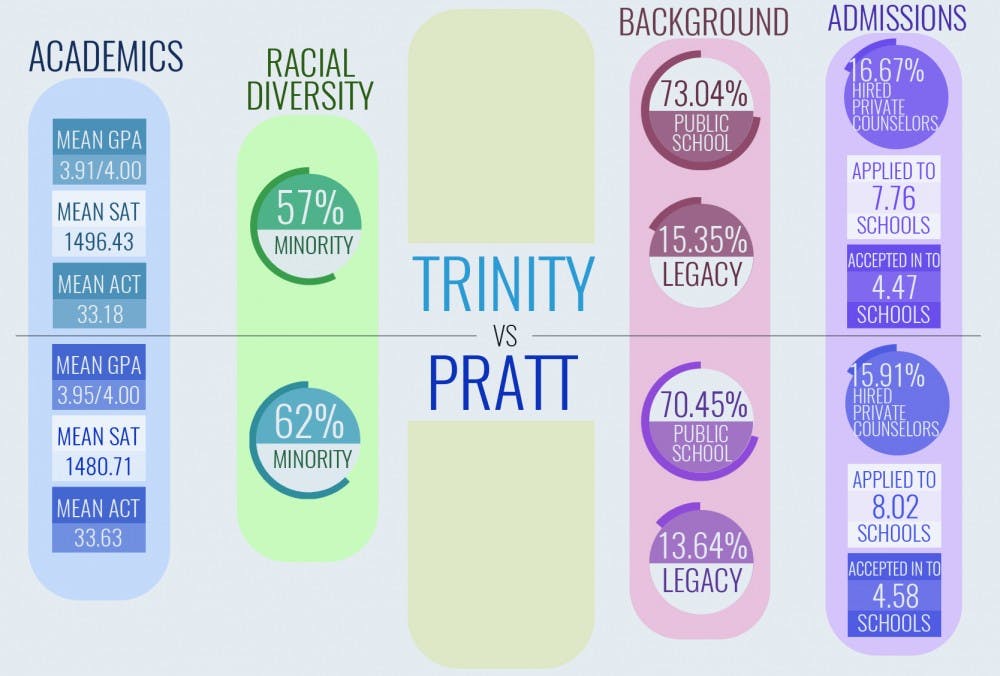Pratt first-years have slightly higher GPAs and are less likely to be legacy students than Trinity first-years, according to a recent Chronicle survey.
This past summer, The Chronicle solicited responses to a survey for members of the Class of 2021, of which 281 students—about 16 percent of the class—took the survey. Some of the questions centered on different aspects of the Duke admissions process, such as test scores, high school GPA and legacy status. Although Trinity first-years answered similarly to Pratt first-years for a few questions, there were also several questions for which the two schools diverged.
One of the starkest differences was in racial and ethnic diversity of the schools. Overall, a little more than 58 percent of survey participants were minority students—which is over-representative of the actual 53 percent of the Class of 2021 that are minorities in terms of race or ethnicity as reported by the Office of Undergraduate Admissions.
The survey reported that 62 percent of Pratt first-years were racial or ethnic minorities compared to about 57 percent of Trinity first-years. Whereas 26 percent of Pratt survey respondents were black or Hispanic, just about 20 percent of Trinity students were black or Hispanic. Both schools had similar proportions of Asian students.
However, Pratt participants had a slightly higher average high school GPA—3.95—than Trinity participants, who averaged at 3.91. On the flip side, Trinity students reported a higher average SAT composite score—about 1500—than Pratt students, who averaged at 1480.
In total, more students in the freshman class took the ACT than the SAT, with 55.7 percent of students reporting having taken the ACT.
The average composite score on the ACT was a 33.25. The lowest score reported was a 26, and the highest a 36—the highest possible score a test-taker can achieve. On the SAT, the overall mean score was a 1493, with the lowest reported score being a 1260, and the highest a 1600—the maximum possible score.
Trinity survey respondents were slightly more likely to come from public schools and hire a private college admissions counselor than Pratt respondents. Overall, about 73 percent of the poll’s participants attended a public school and about one percent were homeschooled. In all, almost 17 percent of participants reported hiring a private college admissions counselor.
Enthusiasm for Duke was similar among both Trinity and Pratt students—about 65 percent of both said that Duke was their first choice. On average, survey respondents applied to eight schools, with a maximum of 30 schools.
About 15 percent of participants had a parent or sibling go to Duke. However, the likelihood that a first-year carries legacy status increased if they are in Trinity, as opposed to Pratt, where about 13.5 percent of survey respondents reported being a legacy student.
More members of the Class of 2021 participated in community service than in any other extracurricular activity in high school, according to the survey.
The poll, which received 281 responses, showed that 16.4 percent of freshmen were involved in service. About 12 percent of students were athletes in high school, although 6.7 percent either played an instrument or were in some kind of music club or band. Another 6.6 percent were on student government, whereas 6.4 percent were part of language clubs.
Some less popular extracurricular involvements included cultural clubs, political clubs, model UN, performing arts, debate and journalism.
Get The Chronicle straight to your inbox
Signup for our weekly newsletter. Cancel at any time.
Class of 2019
Editor-in-chief 2017-18,
Local and national news department head 2016-17
Born in Hyderabad, India, Likhitha Butchireddygari moved to Baltimore at a young age. She is pursuing a Program II major entitled "Digital Democracy and Data" about the future of the American democracy.

